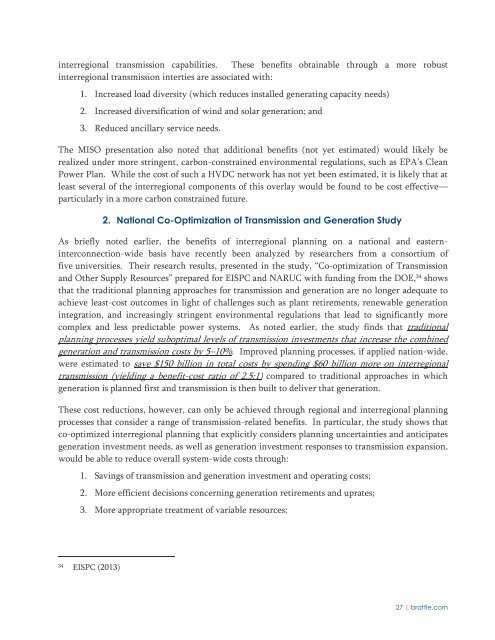THE BRATTLE GROUP
pvrbYG
pvrbYG
You also want an ePaper? Increase the reach of your titles
YUMPU automatically turns print PDFs into web optimized ePapers that Google loves.
interregional transmission capabilities. These benefits obtainable through a more robust<br />
interregional transmission interties are associated with:<br />
1. Increased load diversity (which reduces installed generating capacity needs)<br />
2. Increased diversification of wind and solar generation; and<br />
3. Reduced ancillary service needs.<br />
The MISO presentation also noted that additional benefits (not yet estimated) would likely be<br />
realized under more stringent, carbon-constrained environmental regulations, such as EPA’s Clean<br />
Power Plan. While the cost of such a HVDC network has not yet been estimated, it is likely that at<br />
least several of the interregional components of this overlay would be found to be cost effective—<br />
particularly in a more carbon constrained future.<br />
2. National Co-Optimization of Transmission and Generation Study<br />
As briefly noted earlier, the benefits of interregional planning on a national and easterninterconnection-wide<br />
basis have recently been analyzed by researchers from a consortium of<br />
five universities. Their research results, presented in the study, “Co-optimization of Transmission<br />
and Other Supply Resources” prepared for EISPC and NARUC with funding from the DOE, 34 shows<br />
that the traditional planning approaches for transmission and generation are no longer adequate to<br />
achieve least-cost outcomes in light of challenges such as plant retirements, renewable generation<br />
integration, and increasingly stringent environmental regulations that lead to significantly more<br />
complex and less predictable power systems. As noted earlier, the study finds that traditional<br />
planning processes yield suboptimal levels of transmission investments that increase the combined<br />
generation and transmission costs by 5–10%. Improved planning processes, if applied nation-wide,<br />
were estimated to save $150 billion in total costs by spending $60 billion more on interregional<br />
transmission (yielding a benefit-cost ratio of 2.5:1) compared to traditional approaches in which<br />
generation is planned first and transmission is then built to deliver that generation.<br />
These cost reductions, however, can only be achieved through regional and interregional planning<br />
processes that consider a range of transmission-related benefits. In particular, the study shows that<br />
co-optimized interregional planning that explicitly considers planning uncertainties and anticipates<br />
generation investment needs, as well as generation investment responses to transmission expansion,<br />
would be able to reduce overall system-wide costs through:<br />
1. Savings of transmission and generation investment and operating costs;<br />
2. More efficient decisions concerning generation retirements and uprates;<br />
3. More appropriate treatment of variable resources;<br />
34<br />
EISPC (2013)<br />
27 | brattle.com


